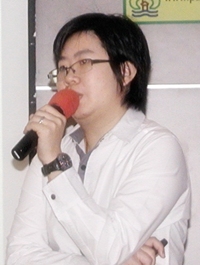It was all about hearing at the Sunday, August 21 regular meeting of the Pattaya City Expats Club at the Amari’s Tavern by the Sea restaurant. Master of Ceremonies Richard Silverberg introduced Tamaporn Srilinjee to speak on what you need to know about hearing loss. Before and during the meeting, several members and guests took advantage of the free hearing tests that were being provided by Bangkok Hospital Pattaya in their mobile hearing booth positioned just outside the restaurant.
Tamaporn received her Bachelor of Arts degree in English in 1999 from Burapha University (Thailand) and her Master of Education degree in Educational Technology in 2004 from the University of Texas at Brownsville (USA). She has been a marketing executive and training manager with Maroongroge Co., Ltd. (Thailand distributer of hearing aids) and international liaison for Logistic Hearing Technologies, Inc. in El Paso, Texas (USA). She has also been a guest lecturer at Ratjapat Suan Dusit University and the Maroongroge Training Center in Bangkok. Her mastery of English was quite evident and led to a very interesting and informative presentation.
 Tamaporn Srilinjee, of Bangkok Hospital Pattaya, speaks to PCEC members and guests on what you need to know about hearing loss.
Tamaporn Srilinjee, of Bangkok Hospital Pattaya, speaks to PCEC members and guests on what you need to know about hearing loss.
Tamaporn said that she would provide information on how we hear, hearing loss, and what can be done about it. First, with the aid of diagrams, she described the anatomy of an ear, which has three main components; the outer ear, the middle ear, and the inner ear. She explained how sound is captured by the outer ear, amplified through the middle ear, and turned into nerve impulses in the inner ear that transmit the sound to the brain.
She then described two types of hearing loss; one being conductive and the other sensory neural hearing loss (SNHL). Conductive hearing loss can often be repaired whereas SNHL can be prevented, but not repaired. The causes of conductive hearing loss can be impacted ear wax, swelling, foreign objects in the ear, congenital (born without some parts of the ear), acute barrotrauma (often experienced by divers), ostoscerosis (more common with females where the three separate bones needed for hearing are fused together), and cholesteatoma (a tumor that can be fatal if not treated). Some common causes of SNHL include infection, congenital, ototoxic poison (from medicines), noise induced, and disease or illness.
She then showed some hearing test charts noting the results which indicate hearing loss based on the level of sound at various frequencies with 0-25 considered normal, 26-30 small hearing loss, 31-50 being moderate, 71-90 being severe, and 91-120 being profound.
 MC Richard Silverberg updates members on PCEC activities for the week.
MC Richard Silverberg updates members on PCEC activities for the week.
If you have hearing loss, the first step is to identify the nature of the loss and whether it can be treated. Conductive hearing loss can often be treated such as removing impacted wax if that is the cause; in other cases surgery may be required. However, for SNHL, the loss cannot be repaired. Often a hearing aid can be used.
Tamaporn noted that there has been a significant improvement in hearing aids in recent years; some that can be placed in the ear making them almost invisible and many can now be remotely controlled for different hearing environments. If the hearing loss is so severe that hearing aids do not work, she said you can have a cochlear implant (surgically implanted electronic device that provides a sense of sound).
After Tamaporn answered many questions from the audience, Richard Silverberg brought everyone up to date on upcoming events and called on member Roy Albiston to conduct the always informative and sometime humorous Open Forum where questions are asked and answered about Expat living in Thailand, recommendations for restaurants and movies are made, an and perhaps a joke or two are told.




